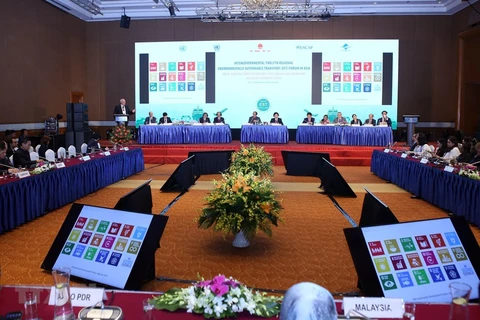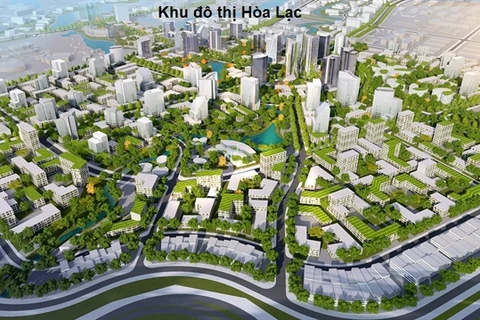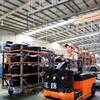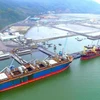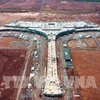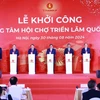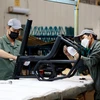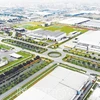Hanoi (VNA) - The current issues of urbanization as well as future challenges in Vietnam are requiring appropriate solutions to help Vietnamese cities to develop sustainably.
In 2008, November 8 was set as annual Vietnam Urban Day to accelerate the process of positive urbanization and raise public awareness of building civilized and modern urban areas.
From war wounds to cities bearing the breath of the era
After the Geneva agreement in 1954, the country was divided into two regions, the North and the South. After nine years of resistance war, the North was devastated. The urgent task was to urgently restore the economy, heal the wounds of war and fulfill the remaining tasks of the democratic national revolution.
In 1956, the Urban Division of the Architecture Department was established, the predecessor of the current National Institute of Urban and Rural Planning. Since then, industrial cities such as Hai Phong, Nam Dinh, Viet Tri and Thai Nguyen were restored to medium and small scale, creating a new hallmark for modern cities of Vietnam. While in the South, Saigon was still the main urban area and a number of large cities and areas with military objectives were also invested to develop.
While the Vietnamese people were trying to rebuild economic regions, the US imperialists waged a war against the North and frantically suppressed the people in the South. With the wicked intention of "bombing the North of Vietnam back to the Stone Age," the 20-year war devastated infrastructure in both the North and the South, making Vietnam’s economic recovery efforts even more difficult.
After the country was reunified, the Vietnamese people quickly embarked on the national restoration and construction. In the first 10 years, the urbanization rate was slow due to the war consequences and inappropriate economic policies.
The Doi Moi (Renewal) policy initiated in 1986 had a strong impact on the social and economic growth of Vietnam, creating a driving force for the formation and development of many new urban areas in the country.
In the early 1990s, Vietnam had about 500 urban areas with an urbanization rate of about 18 percent. This was an important premise for the country to have real growth in the next stage.
Since 1999, Vietnam's urban system has seen many positive changes in both quantity and quality. The number of urban areas increased from 629 in 1999 to 833 urban areas 20 years later. They include two special cities, Hanoi and Ho Chi Minh City, while the rest are cities of tiers 1 to 5.
From a country hard hit by wars and natural disasters with over 80 percent of the population involving in agricultural production and underdeveloped industry, the system of urban areas in the country has been developing strongly.
The cities are increasingly spacious and modern. Many new urban areas, high quality buildings and constructions of regional and international stature have been built. Vietnam's urban areas have not only changed people's lives but also helped boost the nation’s economic growth.
The urban areas contribute about 70 percent of the country's GDP annually and take the lead in industrial production, import and export as well as application of scientific and technological advances, step by step successfully implementing the industrialization and modernization of the country.
The Vietnamese cities are also bright destinations for preserving and promoting the traditional urban space, with the typical cultural features of a nation with a long history.
Coming to Hanoi capital or the ancient town of Hoi An, it is sure that everyone loves the ancient architectural features, cultural activities and cuisine which are preserved in an urban space that has been bustling for hundreds of years.
The harmony between tradition and innovation and between ancientness and modernity will make the Vietnamese cities more attractive but it is posing not easy tasks for urban planners.
Currently, Vietnam's urban system is yet to develop synchronously. Many planning schemes have inappropriate visions and solutions. Management capacity does not keep pace with development reality.
Urban infrastructure fails to meet the requirements of the people. Most of the big cities, especially Hanoi and Ho Chi Minh City, often see traffic congestion, flooding, and environmental pollution.
Plan to develop green growth cities
There are two concepts: green city and green growth city. The green city emphasizes the attention paid to the impact of urban areas on the environment. But the green growth city is defined by the Organization for Economic Cooperation and Development (OECD) as a city that creates economic growth and development through urban policies and activities which reduce adverse impacts on the environment as well as natural resources...
Large cities such as Hanoi, Ho Chi Minh City, Can Tho, Da Nang and Hai Phong have paid attention to changing the urban growth model toward green growth. Some have issued green growth and climate change adaptation strategies like Hai Phong and Can Tho.
Other cities such as Da Nang, Bac Ninh and Tam Ky (Quang Nam) have also studied the building of green growth urban areas.
Experts said that businesses and investors need to research, produce and put on sale green and environmentally-friendly products, services and technologies.
The people themselves can participate in green growth urban development from very small things such as changing habits and lifestyles, replacing nylon bags with paper bags and plastic cups with paper cups, and saving electricity and water.
Urban development - the driving force for economic growth
In Vietnam, the process of national renewal, industrialization and modernization has always been associated with the urbanization process. After more than 30 years of renovation, the urbanization process has been recognizable through the country's socio-economic development stages.
In the period of 1986-1997, the urbanization rate in Vietnam was not fast, reaching only about 23 percent in 1997. It was faster in the 2000-2010 period.
During 2011-2020, Vietnam's economy continued to grow, creating a basis for a strong urbanization process.
As of December 2018, the total number of urban areas nationwide was 833, with an urbanization rate of 38 percent, increasing by 0.9 percent compared to 2017. The rate is expected to hit 40 percent this year.
The increase in urbanization in 2018 helped the real estate and construction materials market achieve positive growth. The average area of housing nationwide was about 24sq.m per person, an increase of 0.6sq.m per person against 2017. Total cement consumption was about 95 million tonnes, up 17 percent year-on-year.
Urban infrastructure has been invested synchronously. The urban appearance is increasingly spacious and modern, with many new urban areas, quality building and constructions of regional and international stature.
With those results, the urban areas have affirmed themselves as the driving force for socio-economic development. The urban economy accounts for 70-80 percent of the total national economy. The GRDP of Ho Chi Minh City and Hanoi alone in 2018 reached 2.4 quadrillion VND or 40 percent of the national GDP./.



